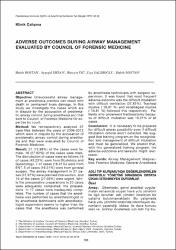| dc.contributor.author | Ertan, Ayşegül | |
| dc.contributor.author | Bostan, Habib | |
| dc.contributor.author | Öz, Hüseyin | |
| dc.contributor.author | Salihoğlu, Ziya | |
| dc.date.accessioned | 08.07.201910:49:13 | |
| dc.date.accessioned | 2019-07-08T20:19:00Z | |
| dc.date.available | 08.07.201910:49:13 | |
| dc.date.available | 2019-07-08T20:19:00Z | |
| dc.date.issued | 2016 | en_US |
| dc.identifier.citation | Ertan, A., Bostan, H., Öz, H. ve Salihoğlu, Z. (2016). Adverse outcomes during airway management evaluated by council of forensic medicine. Haydarpaşa Numune Eğitim ve Araştırma Hastanesi Tıp Dergisi, 56(3), 186-190. | en_US |
| dc.identifier.issn | 1300-6363 | |
| dc.identifier.uri | https://hdl.handle.net/20.500.12511/574 | |
| dc.description.abstract | Objective: Unsuccessful airway management at anesthesia practice can result with death or permanent brain damage. In this study we investigate the cases which are in dispute by the accusation of problematic airway control during anesthesia and that sent to Council of Forensic Medicine for expertise by court. Method: We retrospectively analyzed 37 case files between the years of 2006-2012 which were in dispute by the accusation of problematic airway control during anesthesia and that were evaluated by Council of Forensic Medicine.Result: 27 (72.98%) of the cases were female, 10 (27.02%) of the cases were male. The distrubution of cases were as follows:16 of cases (43.23%) were from Obstetrics and Gynecology, 7 of cases (18.91%) were from ENT, 6 of cases (16.21%) were from general surgery. The airway management in 27 cases (72.97%) were planned intervention, and 10 of the cases (27.03%) were urgent. While the preoperative preparations in 20 cases were adequately completed, the preparations in 17 cases were inadequtely completed. The number of cases that the anesthesia was performed by anesthesiologist or by anesthesia technicians with anesthesiologist supervision seems to higher than the cases that the anesthesia was performed. by anesthesia technicians with surgeon supervision. It was found that most frequent adverse outcome was the difficult intubation with difficult ventilation (37.83%). Tracheal injuries ( 18.91 %) and esophageal injuries ( 10.81 %) followed this respectively. Patients who underwent tracheostomy because of difficult intubation was 16.21% of all cases. Conclusion: It is necessary to be prepared for difficult airway possibility even if difficult intubation criteria aren't detected. We suggest that training program on the recognization and management of difficult intubation and must be generalized. We predict that, with this generalized training program, the adverse outcomes and lawsuits might decrease. | en_US |
| dc.description.abstract | Amaç: Ülkemizde, genel anestezi uygulamaları esnasında oluşan hava yolu yönetimi ile ilgili sorunları adli yönden inceleyen bir çalışma bulunmamaktadır. Bu çalışmada hava yolu yönrtimi sırasında istenmeyen durumların yaşandığı iddiası ile dava konusu olan ve bilirkişi incelemesi için Adli Tıp Kurumu'na gönderilen olgular incelenmiştir.Yöntem: Adli Tıp Kurumu'nda 2006-2012 yıllarına ait hava yolu yönrtimi sırasında istenmeyen durumların yaşandığı iddiası ile dava konusu olan ve görüş bildirilen 37 dosya retrospektif olarak incelendi.Bulgular: Olguların 27'si (% 72.98) kadın, 10'u (% 27.02) erkekti. Klinik branşlara dağılımı incelendiğinde; 16 olgu Kadın Hastalıkları ve Doğum (% 43.23), 7 olgu Kulak Burun Bogaz (%18.91), 6 olgu Genel Cerrahi (% 16.21) 'yi ilgilendiriyordu. Olguların 27'sinde (% 72.97) müdahale planlı, 10'unda (% 27.03) acil idi. Olguların 20'sinde preoperatif hazırlığın tam olarak yapıldığı, 17 olguda da bu hazırlıkta eksiklikler olduğu saptandı. Anestezi uzmanı veya anestezi uzmanı ile birlikte anestezi teknisyeninin anestezi uyguladığı olguların (% 75,67) oranının cerrahın kontrolünde anestezi uygulayan anestezi teknisyeninkilere göre daha fazla olduğu görülmektedir. Zor entübasyon ile birlikte zor ventilasyon (% 37.83) en sık karşılaşılan istenmeyen durum olarak bulundu. Bunu trakeal yaralanmalar (% 18.91) ve özefagus yaralanmaları (% 10.81) takip etti. Zor entübasyon nedeniyle entübe edilemeyen ve trakeostomi açılan olgular tüm olguların %16.21' ini oluşturmaktadır. Sonuç: Zor entübasyon kriterleri saptanmasa bile zor hava yolu gelişme riski göz önünde bulundurularak gerekli hazırlıklar yapılmalıdır. Ayrıca zor havayolunun tanınması ve yönetilmesine yönelik eğitimin yaygınlaştırılması gerektiğini düşünüyoruz. | en_US |
| dc.language.iso | eng | en_US |
| dc.rights | info:eu-repo/semantics/openAccess | en_US |
| dc.subject | Airway Management | en_US |
| dc.subject | Malpractice | en_US |
| dc.subject | Forensic Medicine | en_US |
| dc.subject | General Anesthesia | en_US |
| dc.subject | Havayolu Yönetimi | en_US |
| dc.subject | Malpraktis | en_US |
| dc.subject | Adli Tıp | en_US |
| dc.title | Adverse outcomes during airway management evaluated by council of forensic medicine | en_US |
| dc.title.alternative | Adli tıp kurumunda değerlendirilen havayolu yönetimi sırasında ortaya çıkan istenmeyen durumlar | en_US |
| dc.type | article | en_US |
| dc.relation.ispartof | Haydarpaşa Numune Eğitim ve Araştırma Hastanesi Tıp Dergisi | en_US |
| dc.department | İstanbul Medipol Üniversitesi, Tıp Fakültesi, Cerrahi Tıp Bilimleri Bölümü, Anesteziyoloji ve Reanimasyon Ana Bilim Dalı | en_US |
| dc.authorid | 0000-0003-2342-1214 | en_US |
| dc.identifier.volume | 56 | en_US |
| dc.identifier.issue | 3 | en_US |
| dc.identifier.startpage | 186 | en_US |
| dc.identifier.endpage | 190 | en_US |
| dc.relation.publicationcategory | Makale - Ulusal Hakemli Dergi - Kurum Öğretim Elemanı | en_US |


















